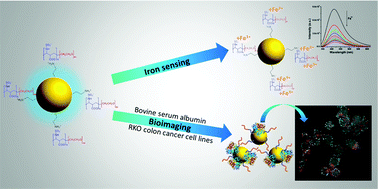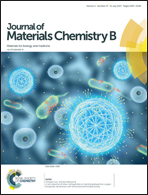Carbon quantum dots/block copolymer ensembles for metal-ion sensing and bioimaging†
Abstract
Fluorescent carbon quantum dots (CQDs) rich in amine moieties that can be easily protonated under acidic conditions were electrostatically interacted with diblock copolymer poly[sodium(carboxylate sulfamate) isoprene]-b-poly(ethylene oxide) (CSS-IEO-3) possessing negatively charged sulfamate and carboxylate species on the CSS part of the diblock copolymer. The so-formed CQDs/CSS-IEO-3 material was found to be stable in a neutral and high salinity environment, which is critical when aiming for biological applications. Moreover, the photoluminescence of CQDs within CQDs/CSS-IEO-3, with emission at 420 nm upon excitation at 320 nm, was unaffected by pH and salinity changes, denoting the absence of significant aggregation phenomena and highlighting the potential of CQDs/CSS-IEO-3 for bioimaging. The photoluminescence of CQDs/CSS-IEO-3 was employed to develop a selective and sensitive method for the facile detection of Fe3+, in the presence of other metal salts, with a detection limit of 8.37 μM. Furthermore, integration of bovine serum albumin (BSA) furnished the three-component CQDs/CSS-IEO-3·BSA nanoensemble, without causing cytotoxicity when subjected to RKO human colon adenocarcinoma cell line. Evidently, confocal fluorescence microscopy allowed the imaging of CQDs/CSS-IEO-3·BSA within living cells, and illustrated its application potential for bioimaging and drug delivery.



 Please wait while we load your content...
Please wait while we load your content...